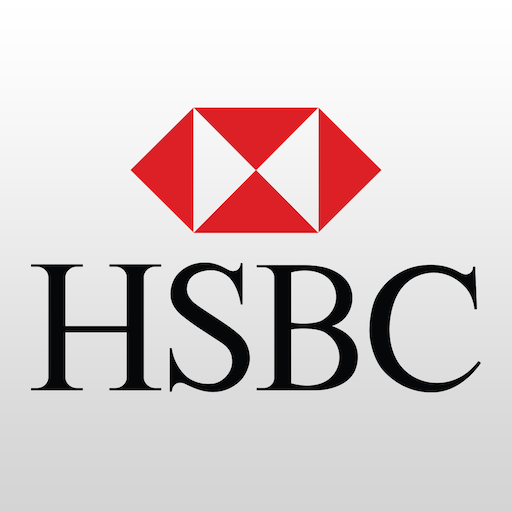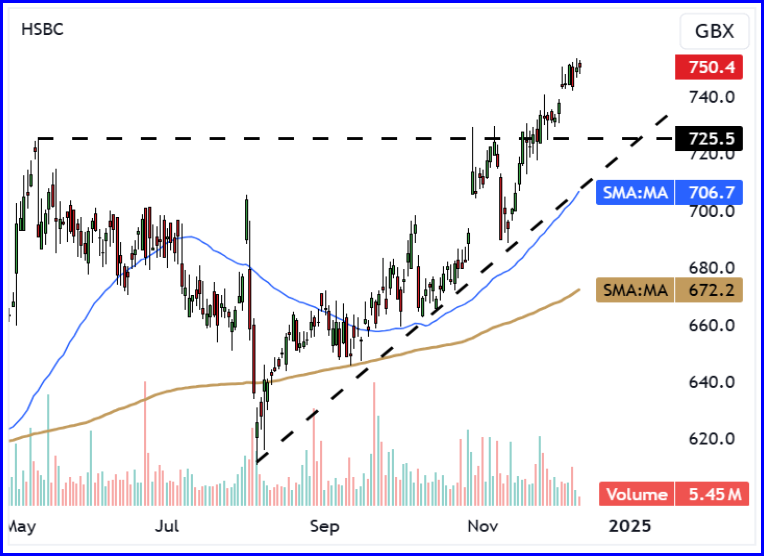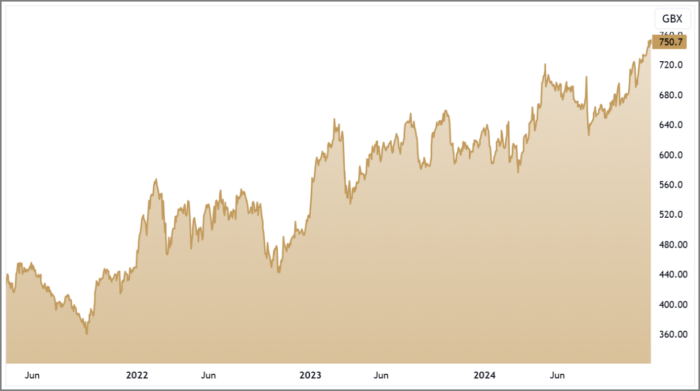11th Dec 2024. 9.01am

Regency View:
BUY HSBC (HSBA) Second Tranche
- Value
- Income

Regency View:
BUY HSBC (HSBA) Second Tranche
HSBC can benefit as China’s stimulus plans shift gears
When we first recommended HSBC (HSBA) back in the summer, it stood out as a high-quality banking play with exposure to key growth opportunities, a diversified revenue base, and a healthy dividend yield.
Now, with a strong Q3 performance and new developments linked to Chinese stimulus efforts, we believe it’s time to add a second tranche.
Positives from Q3 results
HSBC’s latest quarterly results have reaffirmed its position as one of the most well-positioned global banking giants. Despite macroeconomic headwinds, HSBC reported net profit of $4.1 billion for the three months ended 30 September 2024, up 10% year-on-year.
Key highlights from the results included:

Revenue growth: HSBC reported $14.9 billion in Q3 revenue, up 6% compared to the same period last year, primarily driven by Asia’s sustained recovery and higher net interest income (NII). Asia contributed 64% of total group revenue, demonstrating how reliant HSBC remains on this high-growth region despite global market volatility.
Net interest income (NII), a key profitability driver, increased by 8% to $8.3 billion, aided by higher interest rates in key markets like the UK and Hong Kong and sustained loan demand.
Cost-to-income ratio: HSBC’s strategic cost initiatives, including digital transformation and operational streamlining, have paid off. The ratio improved to 50.5%, down from 52.3% in the previous quarter, reflecting improved operational efficiency.
The Q3 figures underscored that HSBC is not only weathering macroeconomic pressures but is actively implementing strategic growth initiatives.
Chinese stimulus: A new catalyst
The Chinese government’s recent announcement of “moderately loose” monetary policy represents a strategic shift from 14 years of monetary prudence, focusing on economic growth rather than strict oversight.
This shift comes in response to slowing consumer spending, a fragile property market, and the need to combat structural economic challenges.
A $140 billion (£110 billion) infrastructure package has also been announced, focused on revitalising sectors such as transport, energy, and technology, aimed at providing sustained fiscal support. This package is expected to have far-reaching effects on both short- and long-term economic momentum, benefitting financial institutions like HSBC.
Here’s how the combination of stimulus measures and changes in monetary policy could bolster HSBC’s growth opportunities:

- Increased liquidity to support borrowing and infrastructure spending: The shift to looser monetary policy will improve liquidity levels, making it easier for businesses and consumers to access financing. This creates opportunities for HSBC to capitalise on higher demand for retail and corporate lending.
- Stabilisation of the property market: Monetary easing will likely provide headroom for investment and market confidence, which could stabilise the housing market and support demand for mortgages—one of HSBC’s key lending areas.
- Consumer spending recovery: Looser monetary conditions and government stimulus are expected to improve consumer confidence and spending. Retail lending, credit card spending, and personal loan demand could receive a significant boost, all of which align with HSBC’s strategic priorities in Asia.
HSBC has strategic exposure to this economic recovery. With 40% of its total group revenue tied to Greater China and Hong Kong, the bank is well-positioned to benefit from these stimulus-driven opportunities.
The infrastructure spending and fiscal stimulus efforts are expected to target transport networks, renewable energy, and technology upgrades, providing opportunities for HSBC’s core lending businesses while supporting longer-term economic recovery. These changes, combined with the loosening of monetary policy, suggest that now could represent a pivotal moment for HSBC to strengthen its strategic positioning.
A breakout with room to run
On the price chart, HSBC’s share price is showing high levels of relative strength…
The shares recently broke through a key area of long-term resistance created by the May 2024 highs. With price having established a foothold above this breakout area we would now expect broken resistance to provide support moving forward.
In terms of valuation, HSBC’s share price is trading on a forward P/E ratio of 9.2x, which is well below the global banking sector average of 10.5x. This suggests that the market is overly conservative about HSBC’s recovery prospects, even though the bank’s operational fundamentals remain sound.

Other key valuation indicators include:
- Dividend yield: HSBC offers a 5.3% dividend yield, which remains well above the average for global banking stocks. This demonstrates strong cash flow generation and an ability to return capital to shareholders even during volatile periods.
- Dividend cover ratio: At 1.8x, HSBC maintains sufficient cover to ensure dividends are sustainable, even during macroeconomic uncertainty.
- Profitability recovery: HSBC’s Return on Equity (ROE) stood at 10.5% in the latest quarter, demonstrating stable recovery as the bank continues to benefit from strategic cost initiatives and market opportunities.
These numbers suggest that the market is underestimating HSBC’s recovery potential. As investors with a longer-term perspective we believe we can take advantage of this relatively low valuation to strengthen our average position at an opportune entry point.
Disclaimer:
All content is provided for general information only and should not be construed as any form of advice or personal recommendation. The provision of this content is not regulated by the Financial Conduct Authority.

